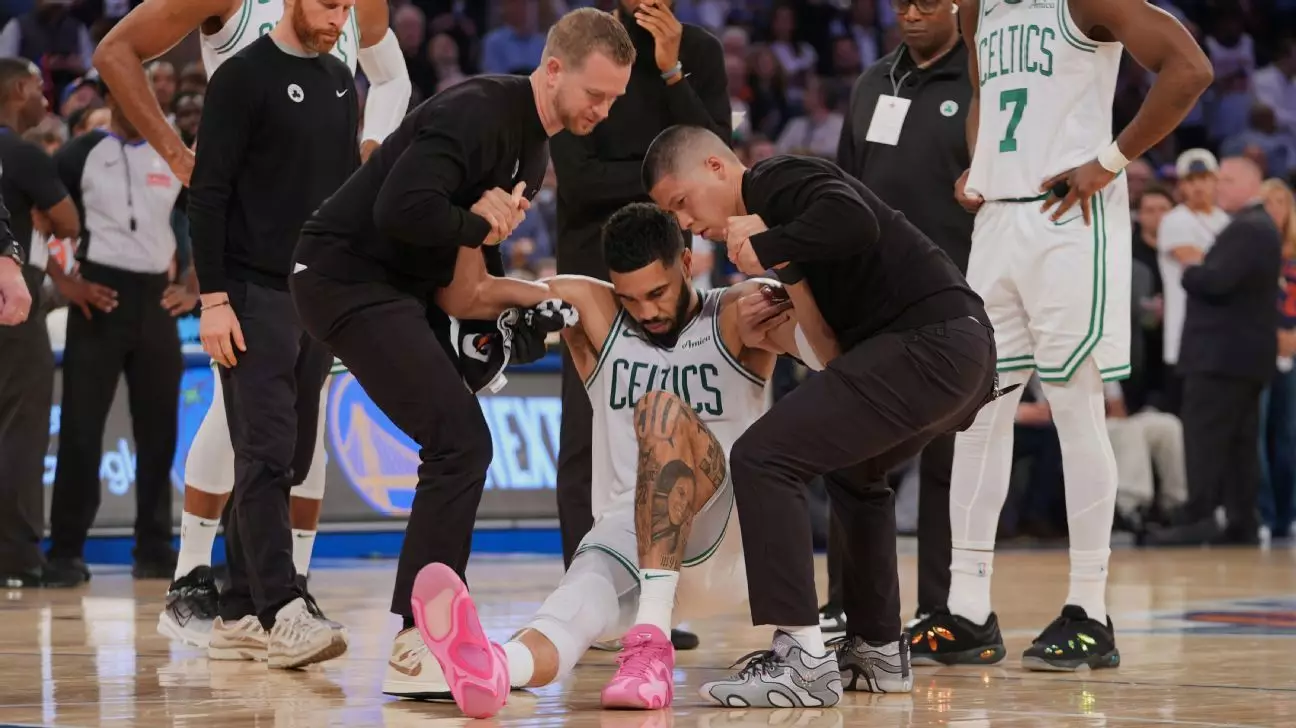On an otherwise thrilling night in professional basketball, the Boston Celtics faced an unforeseen tragedy as their star forward Jayson Tatum suffered a ruptured right Achilles tendon during a playoff game against the New York Knicks. Tatum, who was dazzling fans and analysts alike with an impressive performance—42 points on 16-for-28 shooting—found himself crumbling under the weight of misfortune. The injury, which occurred with just three minutes left in regulation, shifted the narrative from a potential victory to a looming crisis. It was not only a setback for Tatum, but an upheaval for a team that had its eyes set on a deep playoff run, a pursuit now rendered uncertain by Tatum’s injury.
The Emotional Aftermath
In sports, victories and defeats can vary dramatically, but the emotional toll of such injuries transcends statistics. Celtics players were visibly shaken as they gathered in the locker room following the loss, united in concern for their teammate rather than their performance. Center Al Horford summed it up succinctly: “At this point, I’m concerned about Jayson. That’s the most important to me.” Their sense of camaraderie in the face of potential devastation illustrates that basketball is more than just a game; it’s about bonds forged through shared dreams and anguish. The Celtics will now inevitably reassess their championship aspirations without Tatum’s leadership, talent, and undeniable heart.
Tatum’s Legacy and Career Impact
Jayson Tatum has established himself as a cornerstone in Boston’s basketball legacy since being drafted third overall in 2017. With accolades that include being named to the All-NBA first team for what would have been a fourth consecutive season and a strong record in the playoffs, Tatum’s potential seemed boundless. Moreover, his performance during last season underscored his ability to carry the team on his shoulders, leading in points, rebounds, and assists as the Celtics secured their 18th NBA title. To put this into perspective: Tatum’s derailing by injury doesn’t just affect one playoff run; it also complicates a career trajectory that was on the cusp of greatness.
This pivotal moment raises critical questions about how this injury will influence Tatum’s future and the franchise’s long-term aspirations. His ranking as a top-tier performer at just 27 years old creates a formidable contrast to the uncertainty he now faces following surgery. With sacrifices made on the court and accolades obtained, will he be able to return to his previous form, or will this injury mark a turning point in his career?
The Team’s Response: Challenges Ahead
For the Celtics organization, the days ahead promise to be particularly challenging. Beyond the immediate grief over Tatum’s injury, the franchise must reevaluate its strategy. With their star player sidelined, they are confronted with not only the struggle to survive the current playoff series but also a myriad of questions surrounding team chemistry and cohesion. Can they rally as a cohesive unit? Will secondary players step up and fill the void left by Tatum? A team’s mettle is tested in moments like these, and it is in adversity that collective resilience either flourishes or falters.
Beyond the tactical adjustments necessary in Tatum’s absence is the looming specter of psychological impact. Can the Celtics shake the emotional weight of watching a teammate go down at such a critical juncture? The narrative quickly unfolds from a hopeful pursuit of a title to one prominent with wounded spirits and the challenge of recalibrating focus in an unforgiving league. Celtics center Kristaps Porzingis noted the duality of acceptance and urgency quite poignantly after the game: “These things happen… Obviously we all felt for him in that moment, but we just have to keep going.” Can the team effectively channel this kind of resolve into their performance?
The Bigger Picture: A League Tested by Injuries
Tatum’s injury isn’t merely an isolated incident; it reflects a growing trend affecting NBA teams—one that is both alarming and instructive. As the stakes rise, so too does the physical toll taken on athletes. The league’s grueling schedule places immense strain on players, and injuries can derail even the most carefully constructed teams. Observers must now ask: is the structure of modern basketball putting too much at risk? In a league dominated by athleticism and explosiveness, the reality of injuries can change everything in an instant, leaving teams and fans confronting an unsettling vulnerability.
This tragic event in Boston reminds us that the game exists in the nexus of brilliance and fragility. For every anticipated highlight, there’s the ever-looming risk of injury underscoring the athlete’s plight. Thus, Tatum’s journey—once filled with potential breakthroughs now seems fraught with complications—serves as a profound reflection on the human element of sports, a reminder of the risks that accompany heroics on the hardwood.


Leave a Reply